The R&D Center Goes Independent / 1960
The R&D Center that Never Was
A special meeting was held in Tokyo early in 1962 to promote the establishment of Soseikai, an incorporated foundation. According to the minutes of that meeting, Chairman Fukuzo Kawahara (and former executive vice-president of Mitsubishi Bank, then-director of Mitsubishi Metal Corp.) proposed that Takeo Fujisawa (then the senior managing director) explain the purpose of establishing Soseikai.

Copies of the prospectus for establishing Soseikai and the minutes of the Soseikai promotersê meeting (Photograph courtesy by Tasku Date)
Fujisawa began with the following statement:
"There are two objectives in the establishment of this new foundation. The first is to contribute to cultural development through research and associated projects in natural science, cultural, and social science, and in particular, technical promotion. The second is to provide half of the shares in the Honda R&D as a basic asset for the establishment of an incorporated foundation, thereby completing the original mission of an R&D Center that can in turn contribute to society."
The Honda R&D Center was separated from Honda Motor in July 1960 to be a fully independent entity. Fifty percent of its shares belonged to Honda Motor, and the balance was split evenly between Soichiro Honda and Takeo Fujisawa. The plan was to establish Soseikai, based on the latter shares held by Honda and Fujisawa.
Fujisawa spent a great deal of time explaining the second Soseikai objective. He stressed that unless the R&D Center’s independence was secured and the dignity of research maintained, they would be hard pressed to expect significant results. This meant that the Research Division was to remain independent from the structure shared with other divisions handling various tasks such as manufacturing, sales, and accounting. Fujisawa argued that by using 50 percent of the shares held by Messrs. Honda and Fujisawa as a basic asset for the incorporation of a foundation that could be permanently maintained, a force would be created to counterbalance the gigantic influence of major shareholder Honda Motor. Research centers could therefore expand significantly, Fujisawa said, if such equally strong forces were allowed to bring their independence into full play without interfering with or pressuring one another.
Fujisawa added that such R&D’s independence is ideal for manufacturing companies. He said that in time the public would come to appreciate their worth, and that similar R&D centers would spring up everywhere.
Kawahara, upon listening to Fujisawa’s explanation, voiced his respect for Fujisawa’s passion and vision for the establishment of Soseikai. However, he expressed a certain concern regarding the fact that Fujisawa placed such an emphasis on his second goal. He feared that it might invite inaccurate speculation that the aim of establishing the new foundation would really be to enhance the mutual prosperity of Honda Motor and Honda R&D, and that the first goal would be of secondary importance.
After the debate, the prospectus for the establishment of Soseikai and the candidacies for director and trustees of the foundation were deliberated. With Kawahara representing the establishment of Soseikai, an application was to be filed with the Ministry of Education for permission to establish a foundation.
Tasku Date, then the director of Honda R&D and a nominee for the Soseikai directorship, looks back on that time:
"That was when I first was able to understand the full picture of Mr. Fujisawa’s highly respectable idea regarding research centers," he recalled. "Since about the beginning of 1955, Mr. Fujisawa had given a great deal of thought to the way an R&D center should be organized. In July 1960, he made the R&D Center an independent corporation, and Soseikai was to be the finishing touch to his concept of a research center. He was willing to give Soseikai 50 percent of the center’s shares. He had tried to create a unique, powerful R&D center - one unlike anything found in other companies - by putting the directors and employee representatives in charge of Sosekai’s management.
"It was not to be, however. Soseikai simply failed to materialize."
With the establishment of American Honda and a string of decisive wins in the Tourist Trophy (TT) races, 1962 opened with Honda ranked as the world’s top motorcycle maker both in name and reality. Moreover, the company was gaining a foothold in the automotive industry. At about that time, the company was preparing to issue ADRs (American Depository Receipts) in New York to procure funding on a worldwide basis. It was the underwriter Goldman Sachs that warned Honda that a plan to convert Honda R&D’s share percentages to 50 percent ownership by Honda Motor and 50 percent by Soseikai might invite suspicion in the minds of ADR investors, and thus precipitate difficulties.
"A R&D center should rightfully be a subsidiary of Honda Motor," Date remembered. "It was simply unfathomable, and inexcusable, that the research center could exist outside the control of the parent company. As a condition for issuing ADRs, the plan for Soseikai was completely denied."
Test Course: An Ordinary, Public Road
According to a corporate organizational chart dating from March 1954, the engineering design and research divisions that later became R&D Center were located within the Saitama and Hamamatsu factories. The former of these housed the Engineering Design Section of the Technical Development Division, in addition to a Research Section. While the latter housed the Engineering Design Subsection of the Technical Development Section, as well as a research subsection. In April 1954, Saitama Factory reorganized its sections to create the Engineering Design Division, and within that division established the Production Engineering Section, Prototype Engineering Section, and Research Section. As for Hamamatsu Factory, those sub-sections were recognized to become the Engineering Design Section in 1955.
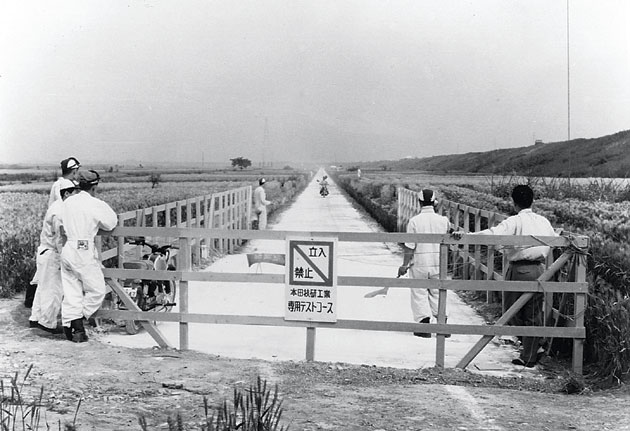
High-speed test course along the banks of Arakawa River
"Around that time," said Date, "Saitama performed the basic design of the Benly and general-purpose engines. Hamamatsu was responsible for drawing up design changes to support the mass-production of these products."
Saitama Factory’s director at that time was Benjiro Honda, the younger brother of Soichiro Honda. The two alternately visited the factory site as often as every half an hour. Soichiro particularly enjoyed his visits to the engineering drawing room and design studio.
"A claim had been made against the Dream Type 4E," Date remembered. "Therefore, in order to deal with it I performed resetting tests on a carburetor. However, President [Soichiro] Honda and the factory director (Benjiro) kept coming to me with instructions. Their ideas came from totally different angles, and I had a tough time facing the pressure I felt from both sides. At one time I even felt compelled to take refuge at the testing center of MITI [Ministry of International Trade and Industry], in Murayama, so that I could concentrate on my ideas."
MITI held performance comparison tests on motorcycles through 1953–54. The proving ground was the Murayama Test Course at MITI’s Machinery Testing Center. Gas-mileage tests, however, were held on an ordinary public street. At Murayama, there were five test categories: acceleration, maximum speed, gas mileage, coasting, and control. Because it was an official test conducted in the presence of ministry officials, the competing companies went to great lengths to obtain good test results.
"The guys who went for testing became frantic," Date said. "President Honda was the kind of man who just would not accept second best. The moment they’d return from the test course, he would always be there, asking, ‘How did it go today?"’
The company also held an in-house endurance test, called the Special Drive Endurance Test, or simply the Special Drive. It consisted of a circular course over public roads through Kawagoe, Kumagaya, Maebashi, and Takasaki. Back then, all those roads were gravel, which caused tires to be buried a number of times. The old Hakone road and Usuitoge peak were used for uphill testing, while Shirako-zaka was chosen as a more conveniently located test road.
Building a Unified Research Team
Honda’s April 1956 company newsletter featured an article by then-General Manager Kenji Yatomi, who wrote about unifying the Engineering Design Division in his article entitled "Recent Structural Changes." In the article, he supported the Research Center’s independence, stating, "the Design Division is scheduled to be set up at the Shirako Plant after unifying the Design divisions of Saitama and Hamamatsu factories. This development, along with the completion of test manufacturing facilities and others, constitutes the basis of the future research center."
Japan was at that time flourishing amid the so-called Jinmu economic boom (1955–57). Accordingly, sales of the Dream and Benly models grew rapidly, causing Honda to increase its production targets. Such changes numbered among the many structural improvements at Honda, all of which were intended to streamline the management for maximum efficiency.
The July newsletter issued the following five-page article by then-Senior Managing Director Takeo Fujisawa, who wrote about the current state and future plans of the company. His chosen title for the piece was quite telling: "In Response to the Question You Have Always Wanted to Ask."
Fujisawa’s article clearly stated the importance of research, and outlined his stance regarding the Research Division: "The reason American corporations are able to achieve such gigantic profits is that they have the ability to sell the products their customers’ demand. The more research and development a company has done, the more this becomes possible. U.S. corporations are generally said to spend 3 percent of their revenues on research, which is truly a significant amount." ... "The most important thing for companies from now on is to emphasize engineering design and prototype fabrication." ... "The products produced through that process will be the driving force in our future stability."
President Soichiro Honda also stressed the Research Division’s importance during a shareholders’ meeting held in April 1957. Referring to the enhancement and improvement of the division, he said, "Basic research regarding design and experiments as well as research with prototype models are not things that are directly reflected on our balance sheet. Instead, their nature is extremely modest in that their effects cannot actually be measured. Their importance, however, is indeed significant. We have invested this division with 200 workers and monthly expenses of up to 20 million yen. This has enabled us to continue improving our products and ensure that they meet the immediate demands of the market. These activities are not simply the foundation of our corporate stability; they enable us to perform our duty as a leader in Japan’s motorcycle industry."
Thus, Honda and Fujisawa fully and honestly shared their perceptions regarding the Research Division.
R&D Center Marks its Approach to the Global Market
A board meeting was held on May 20, 1957, during which it was decided to establish the R&D Center (as of June 1). The R&D Center was to be recognized as an equal organization with an independent structure separate from the head office and its factories.
Fujisawa contributed an article entitled "Joy in the Birth of the R&D Center" to the May 31 issue of the Yamato Factory Bulletin magazine. He wrote, "As the birth of an R&D center had been my long-held wish, I cannot express in words the joy I feel." ... "Creating daring designs and making products that no one else could make: That is all we need to secure Honda’s future and endure amid fierce competition from companies around the world. To accomplish that, first and foremost we will need an abundance of research funding, outstanding talent, and an environment that is conducive to research." ... "I want you all to watch with respect, cooperating with these people, who must agonize over intense intellectual battles in their exploration of new worlds. For the people at the R&D Center to build on new research and come up with wonderful, world-class ideas ensures the future for every Honda employee. As part of Honda’s management, I am confident that this is the way to happiness for all of us."
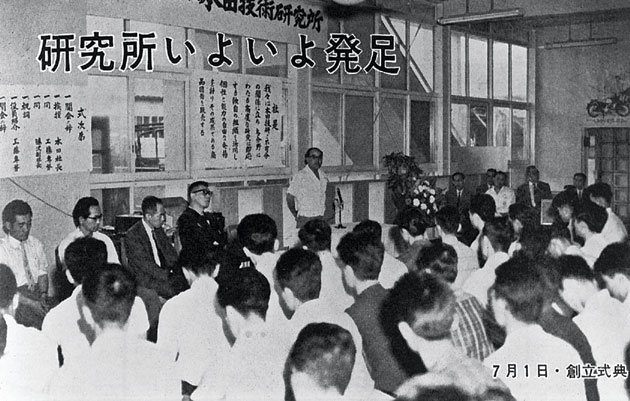
Soichiro Honda addresses the audience at the opening ceremony for Honda R&D Co., Ltd. To his left is Takeo Fujisawa (July 1, 1960).
The position of first general manager at the R&D Center was awarded to Yoshihito Kudo, head of the Design Division. An opening ceremony was held June 1 at Shirako Plant’s second cafeteria. In a moving speech, Kudo expressed his hopes for the endeavor, saying, "With the establishment of our Research Center, we now take our first step toward a new phase. It is part of our growth from the attainment of an international level to leadership on the global level. It must be our goal to progress from being Japan’s leading maker of motorcycles to the top motorcycle maker in the world. Our next goal is to advance into the international market."
Enhancing and expanding the research structure
The Administrative Division, manufacturing machinery section and casting section remaining at the Shirako Plant had by the end of 1957 completed their transfer to the Yamato Plant. Ultimately, this established Honda R&D as an independent structure.
The January 1, 1958, issue of Honda’s company newsletter included a prophetic statement by Kudo: "We would like to make 1958 a year in which our research as well as prototype fabrication capabilities grow by leaps and bounds. Therefore, it’s of urgent necessity that we dramatically bolster our structure, staff, equipment, and layout."

Research and development at the new company building. Even debates among researchers have become livelier.
Honda R&D, as if to prove the point, almost immediately launched the Agricultural Equipment Section, on January 15. Originating at the Hamamatsu Annex three years earlier with the goal of diversifying the Honda business, it was structured as a research and development division emphasizing agricultural machineries. By transferring it to the Shirako R&D Center, it became an independent section. The result of this restructuring bore fruit in the form of the Type F-150 tiller, which in its debut the following May became the foundation for future expansion into the power-products sector.
A much-awaited high-speed test course was completed along the bank of Arakawa River in May 1958. It was a straight, asphalt-paved course 3 meters wide and 1,450 meters long. Significantly, it was also Japan’s first high-speed test track. At the May 27 course opening, Dream motorcycles zipped past the audience at speeds of 150 km per hour, stunning spectators and winning the industry’s full attention. Additionally, Date recalled, "The motorcycle Grand Prix riders demonstrated their skill at flying acrobatics."
Even the course’s established length of 1,450 meters was not sufficient to keep pace with the advance of technology, however, since within a year motorcycle performance had improved so dramatically that additional pavement was needed in order to reach top gear. Subsequently, expansion work was performed at Arakawa. The grand course, completed in February 1959, measured 5 meters in width by 2,200 meters in length. An article in the February 13, 1959, issue of the Yamato Factory Bulletin magazine expressed considerable hope for the high-speed test course:
"The timing is perfect, now that Honda is about to participate in the TT race, where Japan’s motorcycle-manufacturing technology will be tested against the best the world has to offer. With the Dream and Benly securing a place where they can let their ultra-speed come into play, our rapid progress in technology should pick up even more momentum."
A Management Study Meeting Arranged
The year 1958 marked the start of Honda’s full-scale activities outside Japan. For the first time, participation was scheduled for the TT race, and American Honda was being readied for incorporation. Domestically, the RC1600 monopolized the Asama Volcano Race, taking first through third places, while the company’s six-month revenues exceeded 10 billion yen for the first time, reaching 11.3 billion yen. In April 1960, Suzuka Factory was established to cope with a major production increase for the Super Cub C100. Supported by the so-called Iwato economic boom, the Japanese government announced its double-income-increase policy aimed at achieving a degree of growth commensurate with the world’s greatest economies.
The dynamic environment enjoyed by Honda and the rest of the nation led Fujisawa - then the company’s senior managing director - to begin setting up opportunities for the R&D Center’s management to consider splitting off as an independent group. To fulfill that dream, he appealed to section managers through various meetings, in addition to the company newsletters, conveying his belief in the necessity of such a change.
Fujisawa wrote in the March 1960 Honda company newsletter that the recent speed of technical innovation was turning up the heat on business competition. Steadfastly maintaining that a rational research system should be established as quickly as possible, he indicated that the researchers at the center had begun debating their ideas concerning the ideal system of research, and drew up several plans for such a center. "What should a research center be like," he wrote, "in order for it to continue advanced research and achieve significant innovations toward the goal of producing large volumes of high-quality products? A collective wisdom is needed for the answer to this question."
Management study meetings were held twice that May in Oiso, including managers at section-chief level from throughout the entire company. Preliminary group debates and general debates were held regarding the new R&D system.
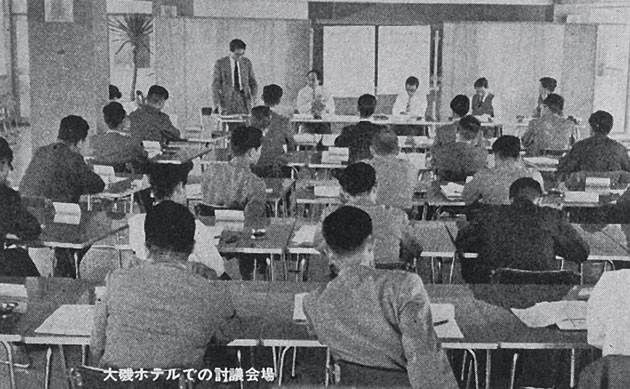
General debate session at the Management Study Meeting held at Oiso in May 1960
Hideo Sugiura, who participated in the study meeting, related details of the situation in his article entitled "Remembering Takeo Fujisawa, Supreme Advisor," published in a special issue of the Honda newsletter on April 7, 1989:
"In May 1960," Sugiura wrote, "it seemed it was our Uncle (a.k.a. Fujisawa) who had set up the two-day meeting of section managers. I remember that on the first day he had led us to the conclusion that we shouldn’t merely ‘produce and sell,’ but ‘produce what sells.’ It was the initial phase of a strategy designed to make the Research Center truly independent. He made us understand what ‘the most important thing for makers to grow’ was, and that it was ‘the foundation for the company on every level of its existence."’
"That evening," he continued, "we went to the Oiso Prince Hotel. The theme of the debate there was whether to make the Research Center independent. We only had practical ideas, so we debated ad infinitum about how the blueprint would be handed over, what the areas of service would be, how the center should be managed, how expenses should be managed, and so on.
"I showed up at the presentation with our conclusion. I still vividly recall the second floor of the hotel, from which we could see the ocean. Seated at the rear of the room was our Uncle Fujisawa.
"He continued to watch me right through to the point when I said, ‘I will now report on our debate.’ He appeared to be on the edge of his seat in anticipation of what I was about to say. However, as soon as I announced, ‘I will first give you our conclusion: We have agreed that at present there is no need for the Research Center to be independent,’ he turned his eyes toward the sea and stared out, unmoving. After that, no matter how loudly I spoke, he would not even attempt to look at me. Looking back now, he was probably feeling like a frustrated father, thinking, ‘These kids have no idea what Iím doing for them."’
Collective Wisdom, Inspired by Genius
The close of the two-day debate saw Fujisawa critiquing the discussions, in which he spoke with passion about the research center he long idealized.
The points he stressed in his speech were:
1. The Honda corporation belongs to an industry existing amid changing times. Therefore, we must always look ahead to the new era. To that end, we must work aggressively to develop products that the times demand.
2. The original blueprint provides up to 99 percent of the driving force behind corporate development, so it’s crucial that the individual who draws up that plan maintain the attitude needed to secure the lifeline.
3. Honda Motor was able to come this far because the company president, Soichiro Honda, had drawn up a superb blueprint. However, we cannot depend on the insight of one genius indefinitely. We need to determine how we can combine our wisdom as an alternative, collective measure, and then build a system that enhances us as a whole.
4. It is important for a research center to allow its individuals to work to their full capacity and concentrate on the task of research. However, this is not likely under a conventional, pyramid structured management system.
5. Preserving the pride and confidence of researchers ultimately preserves the livelihoods of those in Manufacturing, Sales, and other divisions.
Fujisawa concluded his talk with the statement, "I’d like you to think about building a system that offers the best research results. If you conclude that it would be best [for the Research Center] to be independent in a way that everyone can feel happy about, it would be a very good thing."
The participants all heard the issues facing the present center, as Fujisawa had related with his usual flair. Sensing his enthusiasm for a truly independent Research Center, they began to soften their once-steadfast resistance to such an idea.
Years later, when Fujisawa was about to retire from his post as executive vice-president, he recalled that tumultuous time with the words, "There was no doubt in my mind that having this proposal accepted was the only way for us to gain a foothold in becoming a major corporation. I had made up my mind then to resign had the proposal for an independent Research Center been rejected. To this very day I believe it was a turning point for Honda."
Independence Comes to Honda R&D Co., Ltd.
Opening ceremonies for Honda R&D Co., Ltd., were held on July 1, 1960, marking its true independence from Honda Motor. On that occasion Mr. Honda, who was to assume the post of company president, spoke to his audience: "We cannot succeed in this highly competitive world unless we spend a good amount of time creating utterly original ideas. Japan is a country that has traditionally prospered on the strength of its ideas, so today our mission is to grow by investing our time, effort and creativity." Fujisawa, too, spoke of his hopes for the center:
"Have pride and confidence. Put forth that individual effort to create blueprints for wonderful products. I want you to grow to the point of selling our products everywhere in the world, which is the way we’ll earn foreign currency."
Before the Research Center’s independence, on June 16, a special Honda company newsletter entitled "Research Center Independence Becomes Final" was issued. In it was a prospectus written by the seven promoters, including Honda and Fujisawa. The prospectus described the ideal form a research center should take: "The initial concept for the existence of a research institute is to ‘create new values by exploring new, unknown worlds.’ Naturally, it must have its own operational structure and possess a vigorous, pioneering spirit."
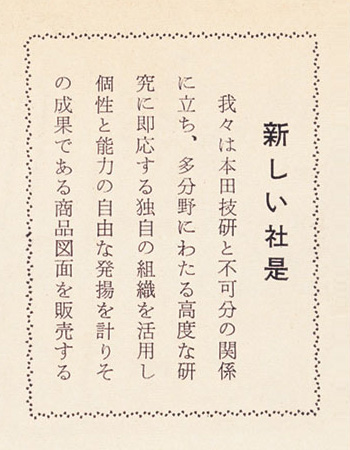
A New Company Principle: "Based on our indivisible relationship with Honda Motor, we will employ a unique system that meets the needs of advanced research throughout a wide range of fields. We will freely promote originality and talent to sell product blueprints that are the fruit of such efforts."

Outline of Prospectus:
1. Establishing a unique organization and research system
2. Improving the quality of design research
3. Promoting independent research
4. Freely choosing the range of research activities
5. Clarifying responsibilities through the establishment of a clear demarcation between research and production
6. Contribution to a wider range of production endeavors
The prospectus stated that while an indivisible relationship with Honda Motor would be maintained, Honda R&D would be founded to ensure the ongoing prosperity of both companies.
The Research Center’s optimal environment was also discussed in the article, "Research Center Independence, from the Perspective of Personnel Relations." That piece mentioned a course of thinking that led to flexible working hours, which had recently begun to be applied at research divisions everywhere: "We must first create an environment in which researchers can concentrate on key issues relating to their expertise, without having to worry about time, job ranking, or other formalities." In 1969, Honda R&D became the first among Japan’s private R&D centers to implement flexible working hours for its research members. Another statement from that period read, "We must realize a new form of personnel management for the Research Center; one that combines the abilities of individual researchers as equal partners and enhances their collective wisdom." Such a statement clearly illustrates Honda’s unique thinking regarding the structure of research centers, which later became known as the "paperweight structure."
The Long-awaited Company Building
The year 1961 saw the construction of the Olympic Road in what was then Yamato-cho, Saitama Prefecture, in preparation for the Tokyo Olympics that were a mere three years away. In November, the much-anticipated new company building on that road was built and the transformation to independence was at last complete. The building was located on a 72,732,000 square meter lot within the grounds of the former Army Preparatory Academy, and was about six times larger than that of the Shirako R&D facility. With that, the shape of an R&D Center befitting the new era was established as a permanent and indelible presence.
The publication Guide to Honda R&D Co., Ltd., created on behalf of the new R&D center offered the following message from Mr. Honda, president of the new company:
Corporate philosophy is the motivating force behind any successful organization. That applies to a research center as well, where the philosophy of those who work there should take precedence over the technologies they implement. I believe that every true technology is the fruit of a consistent and well-considered philosophy.
The true purpose of the R&D Center, I believe, is to send out products that people the world over will cherish. To do so, we must stand firm on our philosophy of maintaining a global perspective and value our theories, ideas and time.
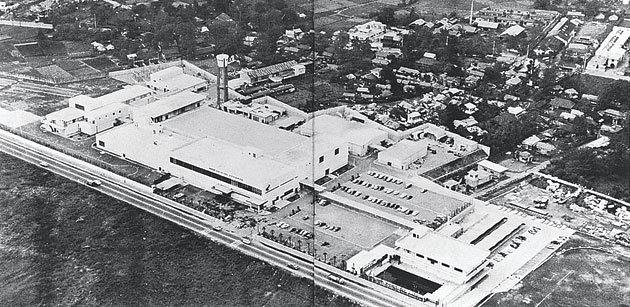
An aerial view of the new company building completed in November 1961